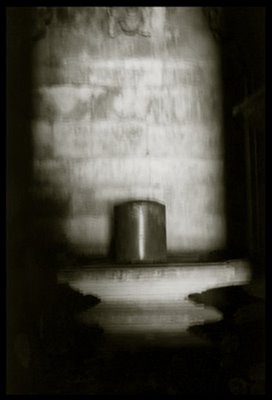The goddess, lesser known throughout the world but one of the most potent deities here, has long intriguied me. Though i am still reasonably unclear about her many forms, i am aware that Kali has ten forms called the ten mahavidhyas, though i dont quite know how the 64 yoginis fit into this pantheon.
The female form has played many roles, as shakti, as the goddess of fertility etc. but strangely few temples have been completely dedicated to Her.
This temple, better known as the Chaunsath Yogini temple, finds other references in the 64 shrines found around Khajuraho. I do not think i am completely equiped to talk about the many forms of the Goddess, but I do know that there is something entirely strange about this temple.
For one, this temple follows none of the old canons of architecture precribed in the holy texts, but is built on a circular ground plan quite unlike all the other temples that are square or complex versions of it. The central platform, possibly a shrine in the olden days is square and has no roof. This temple is not apsidal, therefore it does not have any remote connection with Buddhist influences. Its therefore very clear that these temples attributed to the Mother Goddess, were restricted to themselves and were not half as popular and well known as temples associated with male deities. There is one thing about this temple though, its plan can be very clearly associated with the aniconic symbol of Shiva, The linga with emphasis placed on the Yoni aspect.
Other interesting feature around this temple are that every male deity except Shiva are replaced by a female counterpart including Ganesha. The temple also hosts forms of Bhairava and Chamunda, who are better known as the fierce forms of Shiva and Kali. There definitely has been a lot of tantrik practices that have been taking place here for sure.
One of the most interesting and unique sculptures found here is that of "Ekapada Shiva" or the one legged Shiva. He is also known as Ajaikapada Bhairava. There are only two references to the presence of such a form, one here in Orissa and the other very strangely at Shore temple Mahabalipuram.
All in all, what ever the current state of the temple, it would have been very interesting to see the original form of this temple in completion as well as the potent sacrifices that were done here and the rituals practised here to appease the Goddess Chamunda!
Interestingly Chamunda has always been associated with Bhairava, even in the Vittal Deol temple in Orissa, better known as a remote temple that performed strange human sacrifices to appease this fierce form of the Goddess.





